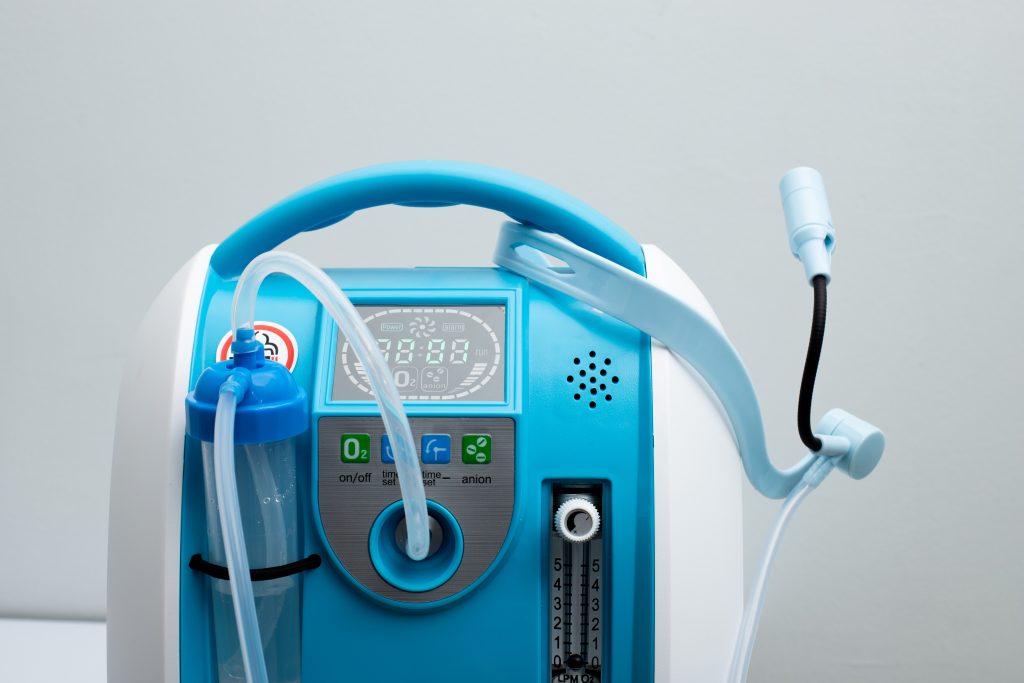You can choose from two main types of oxygen storage systems: stationary and portable. Some storage systems may be used to fill portable systems — combining both types. Most people use a combination of storage systems to keep costs down while maintaining an active lifestyle.
Download Oxygen Storage Systems as a PDF.
We’ll highlight the most common systems here.
Stationary oxygen storage systems
Stationary systems hold a lot of oxygen, but you can’t carry them around with you. Here are three types of stationary systems to choose from:
Oxygen concentrators
Oxygen concentrators are the most common and cost-effective in-home stationary systems. They remove nitrogen from room air to make 94-98% oxygen.
Concentrators are fairly small, weighing between 22-70 pounds. Most come with about 50-feet of supply tubing, which allows you to move around your home. They can achieve a liter flow rate of up to five to six liters per minute. They run on electricity and need an electrical source. So, you’ll need a backup oxygen supply in case a power failure occurs.
These units must be placed in a well-ventilated area and kept away from heat and flames. They also need routine maintenance for inspections, filter changes, and oxygen analysis. Newer models may have an oxygen concentration indicator. This measures the oxygen level administered by the concentrator. If it falls below a certain level, an alarm will sound.
Liquid oxygen reservoirs
These stationary systems have a large reservoir tank, which your oxygen supplier fills once or twice a month.
Reservoir systems require no electricity, have very few moving parts, and require little maintenance or repair. But, when dealing with liquid oxygen, you must be careful not to spill it. That’s because liquid oxygen is extremely cold and can injure the skin immediately upon contact.
A typical liquid oxygen reservoir weighs 124 pounds when filled and contains 31 liters, or 73 pounds, of liquid. At a flow rate of two liters per minute, this amount of oxygen lasts 208 hours or eight days.
Liquid oxygen systems continually lose oxygen through evaporation, even when not in use. They’re great for regular use at home, or for filling up portable units. But they’re not suitable as an emergency backup system.
Compressed gas oxygen
Compressed gas oxygen in large tanks or cylinders is another type of stationary system. These large steel or aluminum tanks are heavy and can’t be moved easily. They must also be safely secured, so they don’t fall over and hurt someone.
Compressed gas oxygen may not be appropriate for some people who need continuous-flow oxygen. This system is better suited as a backup system for a concentrator.
Portable oxygen storage systems
In the past, many people thought oxygen concentrators were for homebound, inactive people. But today’s newer, lighter-weight models are made for people on the move. Many work with car chargers and have battery packs. And some have conserving devices that allow you to spend more time away from home.
Liquid oxygen storage
As we mentioned earlier, most liquid oxygen reservoirs can be used to fill portable units at home. For instance, if you have a large liquid reservoir, you can connect small, portable liquid oxygen units directly to it, and fill them.
Compressed gas oxygen storage
Compressed gas comes in small cylinders in a range of sizes. The smaller ones it into backpacks, fanny packs, or shoulder bags.
The following listing outlines how long each cylinder size lasts at a rate of two liters per minute. If you add a conserving device, you’ll have more time.
- E-cylinder: up to five hours
- D-cylinder: up to three hours
- M9: up to two hours
- M6: up to one hour
E-cylinders weigh about 20 pounds. You can easily wheel one around on a cart or a stroller. Each cylinder has a regulator so you can adjust the flow rate. At a rate of two liters per minute, they only last a few hours.
People who use concentrators often choose E-cylinders for their backup oxygen supply. But, they’re not appropriate as a sole source of oxygen for continuous, long-term therapy.
Note: Medicare only covers the cost of portable systems for use within your home, not for away-from-home activities.
For more in-depth information on this topic, please visit the Big Fat Reference Guide (BFRG). If you are enrolled in AlphaNet’s Subscriber Portal, you can access the BFRG here.
Download Oxygen Storage Systems as a PDF.

